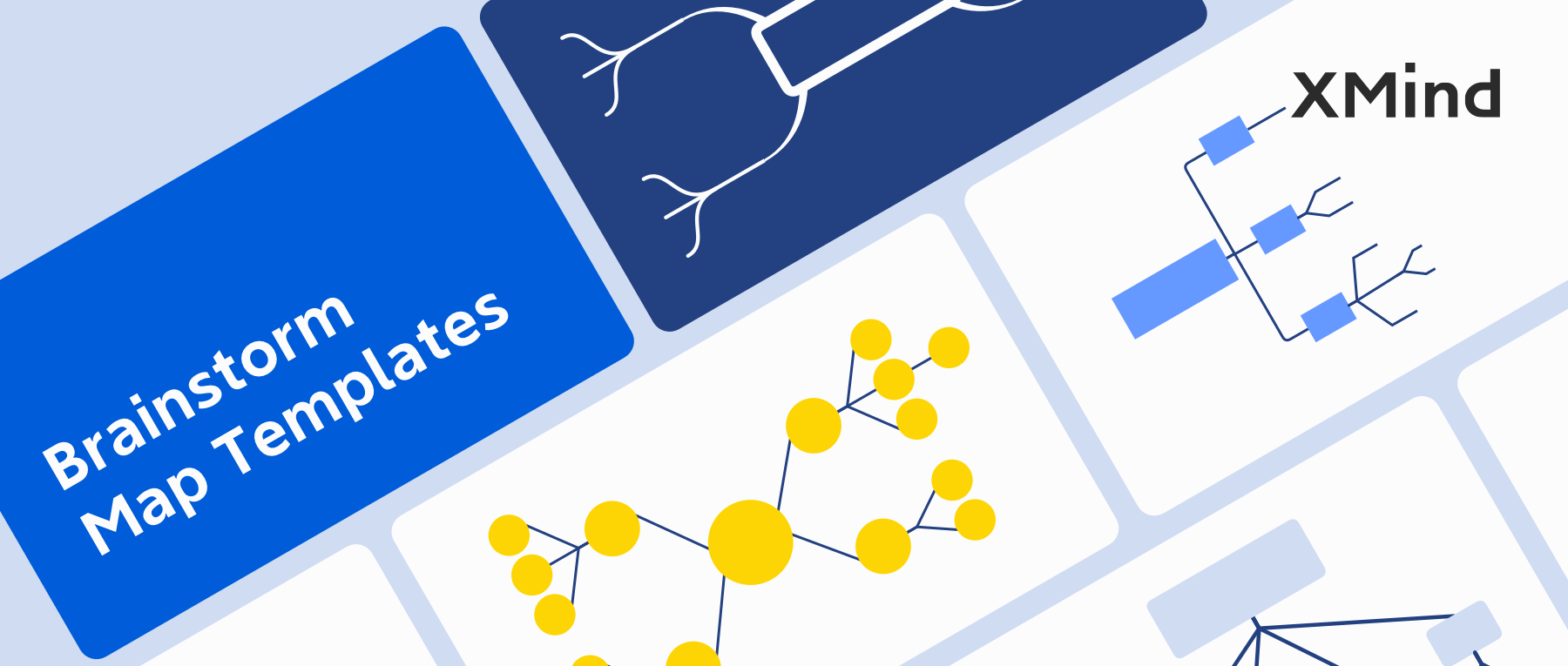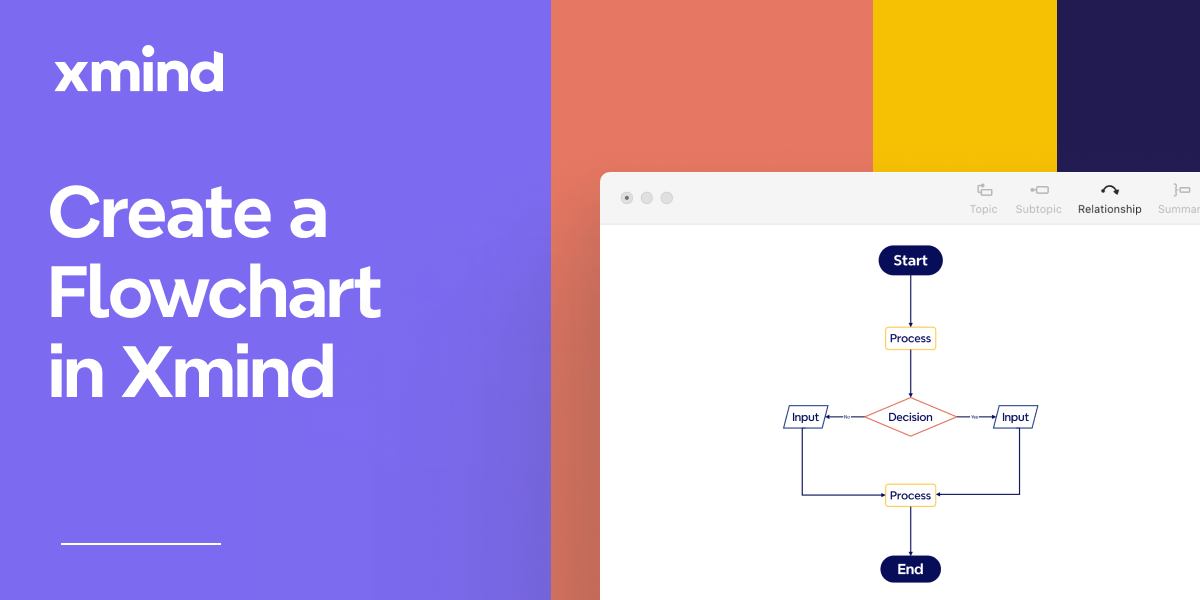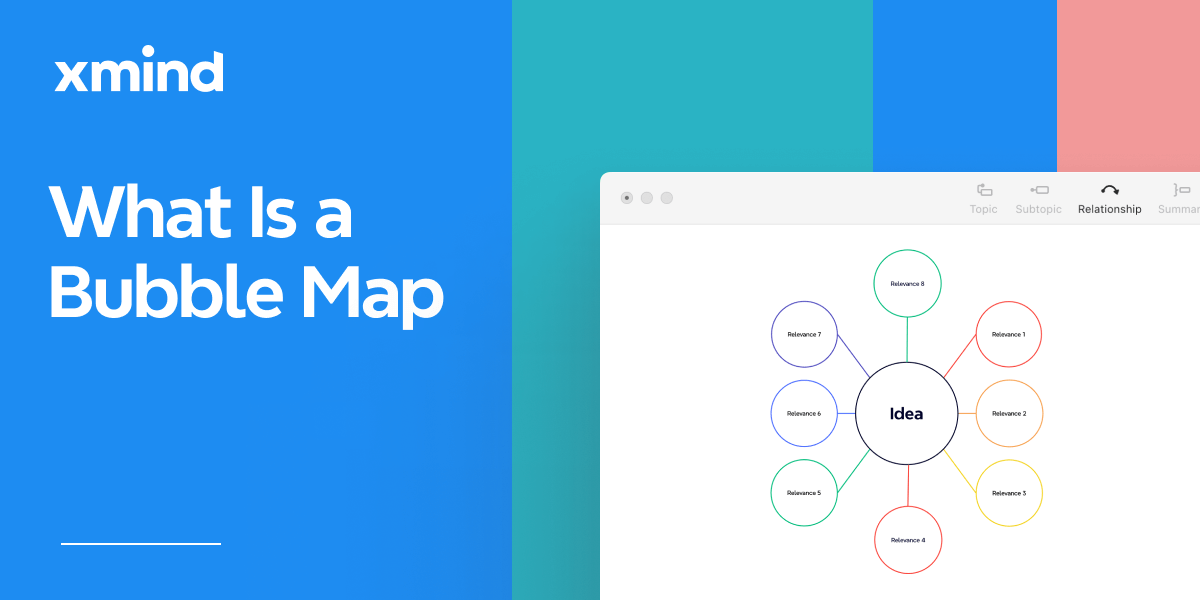Mar 17, 2020
20+ Brainstorming Diagram Templates That Bring out Fruitful Ideations
Mar 17, 2020
20+ Brainstorming Diagram Templates That Bring out Fruitful Ideations
We hear more often about the freedom and no-judgment side of brainstorming. But what we also neglect is that only under proper structures and rules, can brainstorming achieve its best purpose.
A good brainstorming should not go without process in mind.
In this guide, we provide 20+ useful and beautiful brainstorming diagrams that fits best practices for brainstorming processes, ranging from ideation to actions.

First...
Why Use Brainstorming Templates in XMind
Comparing to traditional MS Office templates or a whiteboard, XMind is better in the following ways:
- Free for unlimited time and no registration required. Just download the software and open the templates you download. Boom! You can start to use.
- Digital mind mapping. The radiant (aka center-out) structure of mind maps is perfect for expansion on generated ideas. XMind auto-generates a mind map by just Tab and Enter. Not to mention the countless possibilities of mind maps. They can turn into some cool diagrams, e.g, Starbusting and S.W.O.T analysis. You will see that in a second.
- Different diagrams for different stages of brainstorming, same easy interaction. Tab for sub-level nodes and Enter for same-level nodes. With this interaction, you can create Org-Chart, Timeline, Fishbone, even Matrix for different processes of brainstorming, ranging from ideation to actions. No manual layout.
- Easy drag-and-drop features for reorganizing. You can move a node between different branches by just drag-and-drop.
- ZEN mode for focus and timed sessions. ZEN mode clears out all unnecessary features for brainstorming and calculates the time you spent.
Here is a sneak peek of what brainstorm mapping in XMind looks like:

- Mind map template
- Affinity diagram
- Double bubble map template
- SWOT analysis template
- 5-why analysis worksheet
- Starbusting template
- Reverse brainstorming worksheet
- Marketing brainstorming template
- Brainstorm template for essays
Free-thinking
At this stage, focus on quantity and defer judgment. Use the following maps in a layer-by-layer manner. At ideas inside the inner layer of boxes. Then extend and build on existing ideas by branching out.
Mind Mapping

DOWNLOAD THIS BRAINSTORM MAP TEMPLATE

DOWNLOAD THIS BRAINSTORM MAP TEMPLATE
Mind mapping is almost equivalent to brainstorming nowadays. The method is fairly beginner-friendly (although there are some techniques required to make you a pro.) A typical mind mapping process looks like this:
- Start with writing the problem or topic in the center.
- Put down major perspectives of the topic in the first layer.
- Then write down related ideas for each perspective to the next level.
- Repeat Step 3 until you run dry of ideas.
Tips in XMind
In the process of ideation, you can mark might-be important topics based on gut feelings. In XMind, you can Quick Style a topic to highlight.

Bubble Mapping

DOWNLOAD THIS BRAINSTORM DIAGRAM TEMPLATE
Similar to mind mapping, but even more free-style. Bubble mapping helps to brainstorm on qualities of an idea. Say, if you are thinking of an IT project, what qualities are related to that? Then write the qualities in different bubbles and continuously drill down those ideas.
Question-Storming

DOWNLOAD THIS WORKSHEET TEMPLATE
Often when people are put together, aiming to come up with orignal ideas, people would be stressed to create anything but.
Question-storming, or Q-Storming is designed to solve that problems. Instead of thinking about ideas, participants try to pop up questions around the central issue.
With the series of questions in mind, then any solutions or answers for each idea.
Organize and Compare
When you or your team have enough ideas. Move on to organization and comparisons.
Simple Brainstorming Worksheet

DOWNLOAD THIS WORKSHEET TEMPLATE
This sheet helps you compare the pros and cons of different ideas.
Affinity Diagram

DOWNLOAD THIS DIAGRAM TEMPLATE
This technique is widely used in contextual inquiry or UX design or group data from interviews, observations, and user testings. The process is:
- Record each idea on the node
- Organize related ideas into the same group
- Group related groups under a bigger idea
- Repeat again until the number of the top-level group less than 5 (or agreed number by the team)
Tips in XMind
Use shortcut keys Command+Enter (or Ctrl+Enter on Windows) to quickly create group names.

Double Bubble Mapping

DOWNLOAD THIS DIAGRAM TEMPLATE
A double bubble map compares the similarities and contrasts the differences between the two objects. The objects can be anything, ranging from an idea, a policy, or a person.
The diagram gets its name from having two main circles in which the two items are written. It is similar to the Venn diagram, as the bubbles for similarities are put in between the two compared items, while the differences are put in the outer ring.
If your team already narrows down to two ideas from the storming sessions, a double bubble map would be a good option to better compare them.
Tips in XMind
Use floating topics and relationships to create bubbles.

S.W.O.T. Analysis

DOWNLOAD THIS DIAGRAM TEMPLATE
S.W.O.T. is a must-have in business analysis arsenal. It also comes as a great help for evaluating an idea. By doing this analysis on all selected ideas, you can have a better comparison based on the business viewpoint.
S.W.O.T. analysis divide evaluation by 2 axes: Internal-External, Positive-Negative.
- Strength -> The internal and positive factors. What do you like most about this idea? What is your brand/team’s strength for this solution? What resources you have at your disposal that your competitors do not?
- Weakness -> The internal and negative factors. What do you dislike about it? What are your group’s weaknesses (in resources or abilities) for this solution?
- Opportunity -> The external and positive factors. What are the trends of the society that are for this idea? What is the weakness of your competitors that positively impact this idea?
- Threat -> The external and negative factors. What other company’s solution that we should be mindful of? What are the trends that are against your idea?
P.E.S.T. Analysis

DOWNLOAD THIS DIAGRAM TEMPLATE
The S.W.O.T. analysis deals with both internal and external factors, while P.E.S.T digs more on the external factor alone.
The analysis is conducted quite similar to S.W.O.T. analysis. In the above section, I mentioned the trends of society and other company’s solutions in external analysis. However, sometimes those factors could be as many as hundreds in real-world settings. That’s why people introduce P.E.S.T. analysis in their brainstorming evaluation.
- Political -> Laws. Policies, human rights, etc,. For example, for an idea about a tea product. What is the food safety policy for tea? What are the regulatory fees for tea? How about the negotiation power of the labor force?
- Economical -> Economic growth, consumer confidence, purchasing power, etc,. What is the competition from the retail stores? Is this business seasonal? How much is the maintenance fee?
- Social -> Social culture, lifestyle, and social benefits, etc,. What is the consumers’ preference for drinks? How about moral issues on tea-farming? How long is the product life cycle?
- Technological -> Innovation technology and acceptance of new technologies, etc,. How easy is it to be copied? How much does it cost for R&D?
Concept Mapping

DOWNLOAD THIS DIAGRAM TEMPLATE
The concept map shows the relationship between different concepts. The core elements are nodes, cross-links and linking verbs (on the connection lines). It is useful for analyzing some connected ideas and coming up with new angles.
Before the final map, you have to go through series of re-organization. It is by this rigorous process that you come up with new angles of a whole network of knowledge. The steps of concept mapping are:
- Copy and paste the list of ideas you come up with at the free-thinking stage.
- Then organize them for at least 3 times until you think you have a better understanding of this group of ideas.
- Connect ideas in the same group and create cross-links for ideas of different groups.
- Write downlinking phrases on each connection line.
- Visually separate different groups of ideas by using different formats.
- Fine-tune and layout.
Further Reading
Evaluate and analysis
The following are templates that combine both problem analysis and solution brainstorming processes.
5 Whys’ Analysis
“It is very important for young people keep their sense of wonder and keep asking why.”

DOWNLOAD THIS DIAGRAM TEMPLATE
As its name suggests, 5 why’s analysis forces you to ask the cause for 5 times. That’s why it is also called root-cause analysis, as each time you ask why you dig one level deeper in the reason behind.
It is possible when you ask why for 3 or 4 times, you think you already reach the root cause. Or the opposite, after 5 times of reason digging, you still haven’t reached the bottom. The number 5 is more a suggested number than the best number.
After you finish asking, write down countermeasures targeting the root cause. And compare your measurements with the original problem to see whether it is sufficient to stop the problem from arising again.
Cause-and-Effect Analysis

DOWNLOAD THIS DIAGRAM TEMPLATE
Nicknamed fishbone diagram, cause-and-effect analysis is similar to 5 why’s analysis above. Both are trying to track down the root cause of a certain effect.
- Identify the problem and write it in the “fish head”.
- Write down the major factors in the “fishbone” closest to the spine.
- List out possible causes for each major factor in the outer “fishbones”.
- Analyze the cause and highlight the important ones to the next step. Use stickers or boundaries to mark the important causes. Then discuss in the group about actions for investigation.
Tips in XMind
Use Command+1 (orCtrl+1) to quickly add priority markers in the boxes.

S.C.A.M.P.E.R. Method

DOWNLOAD THIS BRAINSTORM TEMPLATE
S.C.A.M.P.E.R. method helps you expand and improve upon current ideas from different perspectives. Each letter represents a series of questions:
- Substitute -> What if we substitute element an of idea B to element b of idea A?
- Combine -> What if we combine idea A with idea B?
- Adapt -> What changes need to made to modify idea C in different contexts?
- Modify -> What could we modify to make this idea better? What other context does this idea work better?
- Eliminate -> What could we remove from the project to simplify it?
- Reverse -> How can we change or reorder these ideas? How could we reorganize the steps for this idea to make it more effective?
Starbusting

DOWNLOAD THIS ANALYSIS TEMPLATE
The template is the mind map version of starbursting. Starbusting is a visualized version of 5W1H (Who. When. What. Where. Why. How). It works best for developing product or event ideas.
Put your idea in the center and then answer each question to slowly form an actionable proposal for a rough idea.
Reverse Brainstorming

DOWNLOAD THIS DIAGRAM TEMPLATE
Reverse brainstorming is a technique that combines both reversal thinking and brainstorming. Participants try to come up with “solutions” that achieve the opposite effect. It works great when your team is getting tired of a typical brainstorming session.
Say, for example, you want to improve customer satisfaction for a health clinic.
Your team would easily come up with reversed ideas like, “Book the appointment on the wrong date”, “Long waiting time”, etc. These “terrible” ideas work as a check-list for the team to go through possible loopholes.
To reverse brainstorm, the steps are:
- Put the reverse problem statement in the central topic of the canvas.
- Write down things that will make this problem happen.
- Brainstorm solutions to counter-attack each point listed in step 2.
- Evaluate each solution and tag them as, “Take Action!!”, “More Research Required”, and/or “More Discussion Required”
- (Optional) Elaborate on detailed steps or questions.
Take Actions
Flowchart/Process Chart

DOWNLOAD THIS FLOWCHART TEMPLATE
A flowchart is a diagram that visualizes a process or sequence of a workflow. It works best for continuous improvement in an established process.
More Templates
Marketing Brainstorming Template
Marketing Strategy

DOWNLOAD THIS DIAGRAM TEMPLATE
Perspective Brainstorming

DOWNLOAD THIS WORKSHEET TEMPLATE
Brainstorming Template For Essay Writing
Column Organizer

Webbing

Organization Strategy Map

DOWNLOAD THIS BRAINSTORMING TEMPLATE
User Story Mapping

DOWNLOAD THIS BRAINSTORMING TEMPLATE
Above are templates I created and curated for your brainstorming. What do you think about them? Tweet we if you have any questions :) !
More Posts
Flowchart Essentials: Definition, Templates, and Free Softwares
Discover the power of flowcharts with our detailed guide. Learn what a flowchart is, explore practical use cases, and discover how to create and optimize them using softwares like Xmind and Xmind AI for enhanced workflow efficiency.

Bubble Maps: Definition, Examples, and How to Create in Xmind
Discover the power of bubble maps for data visualization with our comprehensive guide. Learn about different types, practical applications, and best mind mapping tools like Xmind. Get step-by-step instructions and expert tips to create stunning bubble maps for brainstorming, project management, and report writing.

The Complete Guide to Organizational Chart [2024]
Discover the simple steps to build dynamic organizational charts with Xmind.


One space for all your ideas
Organize thoughts, visualize structures, connect ideas, and unlock insights.
Get Started for Free


